Physical Address
304 North Cardinal St.
Dorchester Center, MA 02124
Diagnostic ultrasound is an accurate means of evaluating most scrotal processes and can supplement the physical examination.
Solid intratesticular lesions have a high likelihood of malignancy, whereas cystic extratesticular intrascrotal lesions are almost certainly benign.
Doppler sonography is the most useful and most rapid technique to assess the patient with acute scrotal pain. Ultrasound can establish the diagnosis of testicular ischemia and help distinguish torsion from other causes of acute pain such as epididymitis and epididymo-orchitis.
In the setting of acute scrotal trauma, sonography has a primary role to evaluate the continuity of the tunica albuginea and assess for testicular rupture, which requires early surgical intervention.
Varicocele is the most common correctable cause of male infertility and is diagnosed by ultrasound by visualization of dilatation of the veins (>2-3 mm and increasing in size with Valsalva maneuver or standing) of the pampiniform plexus located posterior to the testis.
Diagnostic ultrasound is the most common imaging technique used to supplement the physical examination of the scrotum and is an accurate means of evaluating many scrotal processes. Technical advancements in high-resolution real-time sonography and the ability of color and power Doppler sonography to evaluate testicular perfusion have improved and expanded the clinical applications of scrotal sonography to include (among other indications) assessment of scrotal masses, evaluation of acute scrotal pain, evaluation of scrotal trauma, assessment of varicoceles in the infertility workup, assessment for tumors and metastatic disease, and evaluation of an undescended testis.
Evaluation of location and characteristics of scrotal masses
Evaluation of acute scrotal pain
Evaluation of scrotal trauma, including surgical or iatrogenic injury
Evaluation for varicoceles in infertile men
Evaluation of testicular ischemia with color and power Doppler sonography
Follow-up of patients with previous testicular neoplasms, lymphoma, or leukemia
Detection of occult primary tumor in patients with known metastatic disease
Localization of the undescended testis
Scrotal ultrasound examination is performed with the patient in the supine position. The scrotum is elevated on top of a towel draped over the thighs, and the penis is placed on the patient's abdomen and covered with a towel. Optimal results are typically obtained with a high-frequency (14-18 MHz) linear array transducer. If greater penetration is needed because of scrotal swelling, a lower-frequency transducer may be used. A direct-contact scan is performed using acoustic coupling gel. Images of both testes are obtained in transverse and sagittal planes. The size and appearance of each testis and epididymis should be noted and compared to the contralateral structures. Color and pulsed Doppler parameters should be optimized to evaluate for low flow velocities and to demonstrate blood flow in the testes and surrounding structures. Transverse images including portions of both testes should be acquired in gray-scale and color Doppler modes to demonstrate symmetry. Scrotal structures should be examined thoroughly to evaluate for extratesticular masses or processes. Additional techniques, such as upright positioning of the patient or performing the Valsalva maneuver, may be used to evaluate venous vascularity for varicocele or for inguinal hernia assessment.
The normal scrotal wall consists of the epidermis, superficial dartos muscle, dartos fascia, external spermatic fascia, cremasteric muscle and fascia, and internal spermatic fascia. The scrotum is a fibromuscular sac that is divided by the midline raphe, forming a right and left hemiscrotum. Each hemiscrotum contains a testis, epididymis, spermatic cord, and vascular and lymphatic networks ( Fig. 22.1 ).
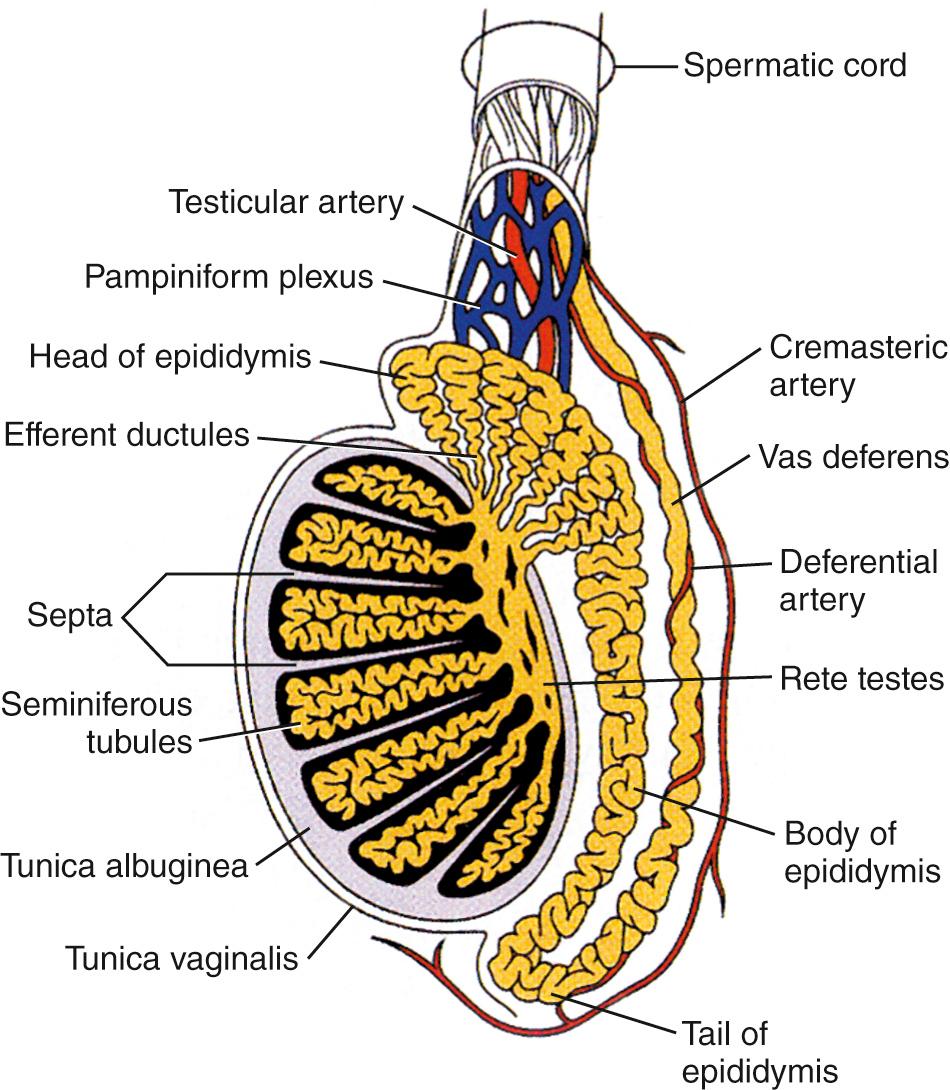
The two layers of the tunica vaginalis separate the testis from much of the scrotal wall and form an isolated mesothelial lined sac. During embryologic development, the tunica vaginalis arises from the processus vaginalis, an outpouching of fetal peritoneum that accompanies the testis in its descent into the scrotum. The upper portion of the processus vaginalis, extending from the internal inguinal ring to the upper pole of the testis, is normally obliterated. The lower portion, the tunica vaginalis, remains as a closed pouch within each hemiscrotum, partially folded around the testis. Only the posterior aspect of the testis, the site of attachment of the testis and epididymis, is not in continuity with the tunica vaginalis.
The inner or visceral layer of the tunica vaginalis covers the testis, epididymis, and lower portion of the spermatic cord. The outer or parietal layer of the tunica vaginalis lines the walls of the scrotal pouch and is attached to the fascial coverings of the testis. A small amount of fluid is normally present between these two layers.
The fibrous tunica albuginea covers and protects the testis. Posteromedially, the tunica albuginea projects inward into the testis to form the mediastinum. Numerous fibrous septations project inward from the mediastinum, dividing the testis into 250 to 400 lobules. Each lobule consists of one to three seminiferous tubules supporting the Sertoli cells and spermatocytes. The Leydig cells are adjacent to the tubules, within the loose interstitial tissue, and are responsible for testosterone secretion.
The adult testes are ovoid glands measuring 3 to 5 cm in length, 2 to 4 cm in width, and 3 cm in anteroposterior dimension. Testicular size and weight decrease with age. Sonographically, the normal testis has relatively homogeneous, medium-level, granular echotexture ( Fig. 22.2A ). Prepubertal testes are typically less echogenic than postpubertal testes secondary to incomplete maturation of the germ cell elements and tubules. The tunica ( tunica vaginalis and tunica albuginea ) can often be seen as an echogenic outline of the testes. Where the tunica invaginates to form the mediastinum testis, the mediastinum testis is sometimes seen as a linear echogenic band extending craniocaudally within the testis ( Fig. 22.2C ). Its appearance varies according to the amount of fibrous and fatty tissue present. The fibrous septum, or septula testis, may be seen as a linear echogenic or hypoechoic structure ( Fig. 22.2B ).
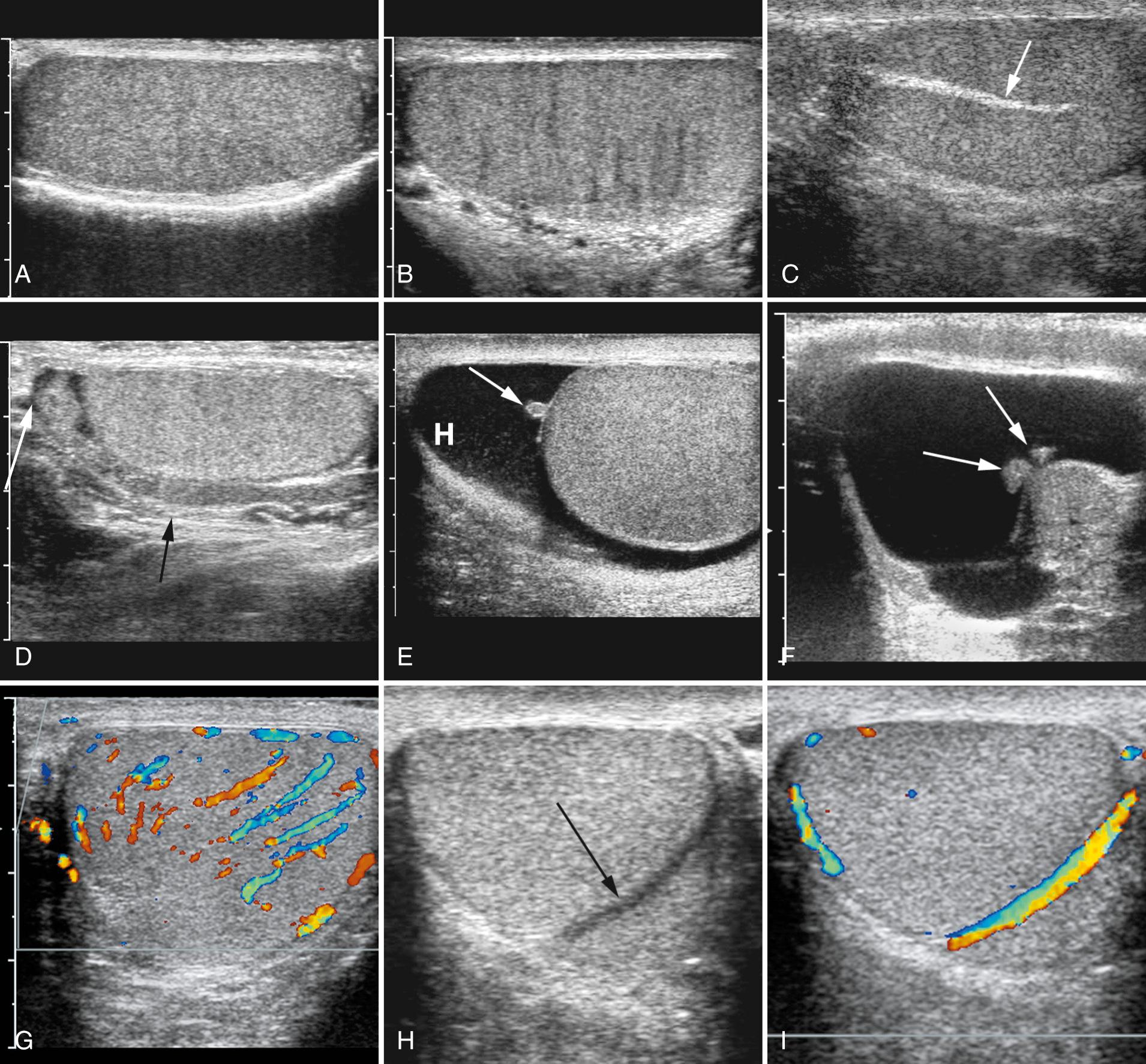
The seminiferous tubules converge to form larger tubuli recti, which open into the dilated spaces of the rete testis. The normal rete testis can be identified in 20% of patients as a hypoechoic region near the mediastinum. The rete testis drains into the epididymal head via 15 to 20 efferent ductules.
The epididymis is a curved structure measuring 6 to 7 cm in length and lying posterolateral to the testis. It is composed of a head, a body, and a tail. The pyramid-shaped epididymal head, or globus major, is located at the superoposterior aspect of the testis, measuring 5 to 12 mm in diameter ( Fig. 22.2D ). It is formed by the efferent ductules from the rete testis, which join together to form a single convoluted duct, the ductus epididymis. This duct forms the body and the majority of the tail of the epididymis, measures approximately 6 m in length and follows a convoluted course from the head to the tail of the epididymis. The body (corpus) of the epididymis lies adjacent to the posterolateral margin of the testis. The tail (globus minor) is loosely attached to the lower pole of the testis by areolar tissue. The ductus epididymis forms an acute angle at the inferior aspect of the globus minor and courses cephalad as the vas deferens to the spermatic cord. Sonographically, the epididymal head is normally isoechogenic or slightly more echogenic than the testis, and its echotexture may be coarser. The body tends to be isoechoic or slightly less echogenic than the globus major and testis. The normal body measures less than 4 mm in diameter, averaging 1 to 2 mm.
The appendix testis, a remnant of the upper end of the paramesonephric (Müllerian) duct, is a small ovoid structure usually located on the superior pole of the testis or in the groove between the testis and the head of the epididymis. The appendix testis is identified sonographically in 80% of testes and is more readily visible when a hydrocele is present ( Fig. 22.2E ). The appendix testis may appear stalklike and pedunculated, cystic, or even calcified. The appendices of the epididymis are blind-ending tubules (vasa aberrantia) derived from the mesonephric (Wolffian) duct; they form small stalks, which may be duplicated, and project from the epididymis ( Fig. 22.2F ). In rare cases, other appendages, such as the paradidymis (organ of Giraldés) and the superior and inferior vas aberrans of Haller, may be seen. The appendages of the epididymis are most often identified sonographically as separate structures when a hydrocele is present.
Knowledge of the arterial supply of the testis is important for interpretation of color flow Doppler sonography of the testis. Testicular blood flow is supplied primarily by the testicular, deferential, and cremasteric (external spermatic) arteries. The testicular arteries arise from the anterior aspect of the aorta immediately below the origin of the renal arteries. They course through the inguinal canal with the spermatic cord to the posterosuperior aspect of the testis. On reaching the testis, the testicular artery divides into branches that pierce the tunica albuginea where the capsular arteries form and arborize over the surface of the testis in a layer known as the tunica vasculosa, deep to the tunica albuginea. Centripetal branches arise from these capsular arteries; these branches course along the septa to converge on the mediastinum. From the mediastinum, these branches form recurrent rami that course into the testicular parenchyma, where they branch into arterioles and capillaries ( Fig. 22.2G ). In about 50% of normal testes a transmediastinal artery supplies the testis, entering through the mediastinum and coursing toward the periphery of the gland to supply the capsular arteries, and is accompanied by a large vein, frequently seen as a hypoechoic band in the midtestis ( Fig. 22.2H and I ). The transmediastinal artery may be associated with acoustic shadowing obscuring the distal aspect of the testis and giving rise to the “two-tone” testis appearance. The deferential artery originates from the superior vesical artery and courses to the tail of the epididymis, where it divides and forms a capillary network. The cremasteric artery arises from the inferior epigastric artery. It courses with the remainder of the structures of the spermatic cord through the inguinal ring, continuing to the surface of the tunica vaginalis, where it anastomoses with capillaries of the testicular and deferential arteries.
The velocity waveforms of the normal capsular and intratesticular arteries show high levels of antegrade diastolic flow throughout the cardiac cycle, reflecting the low vascular resistance of the testis ( Fig. 22.3A ). Supratesticular arterial waveforms vary in appearance. Two main types of waveforms exist: a low-resistance waveform similar to that seen in the capsular and intratesticular arteries, reflecting the testicular artery; and a high-resistance waveform with sharp, narrow systolic peaks and little or no diastolic flow ( Fig. 22.3B ). This high-resistance waveform is believed to reflect the high vascular resistance of the extratesticular tissues. The deferential and cremasteric arteries within the spermatic cord primarily supply the epididymis and extratesticular tissues, but they also supply the testis through anastomoses with the testicular artery.
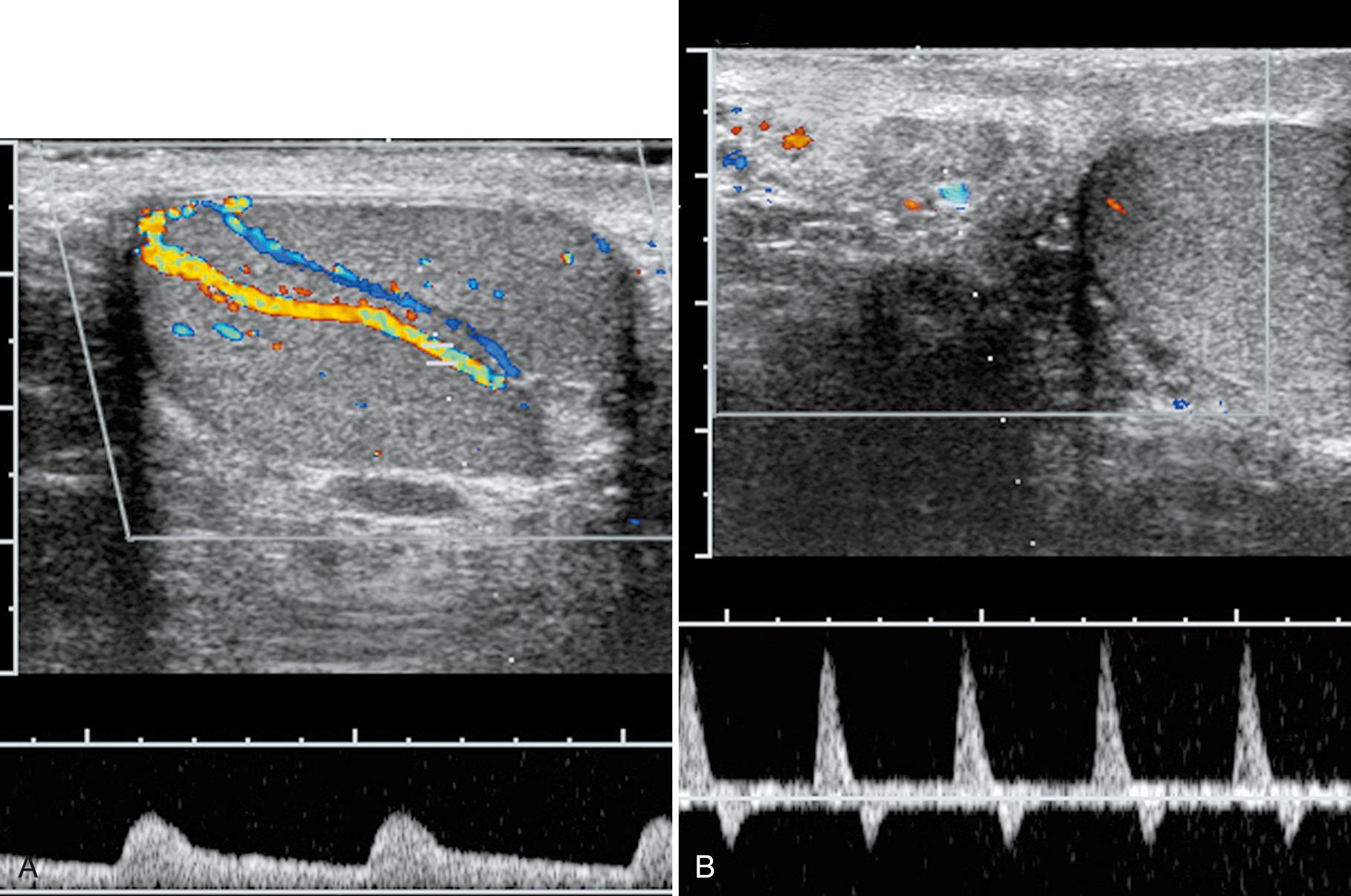
The spermatic cord consists of the vas deferens; the testicular, cremasteric, and deferential arteries; a pampiniform plexus of veins; the lymphatics; and the nerves of the testis. It courses superiorly toward the superficial and deep (also called “internal”) inguinal rings. Sonographically, the normal spermatic cord lies just beneath the skin and may be difficult to distinguish from the adjacent soft tissues of the inguinal canal. Distally, it may be visualized within the scrotum when a hydrocele is present or with the use of color flow Doppler sonography.
When a scrotal mass is palpated, the concern is for the presence of a testicular neoplasm. With sonographic examination, intrascrotal masses can be detected with a sensitivity of nearly 100%. Delineation between intratesticular and extratesticular processes is 98% to 100% accurate. In general, intratesticular masses should be considered malignant. If the mass is extratesticular and cystic, then this process is almost certainly benign, with the general accepted prevalence of malignancy of extratesticular lesions being 3% to 6%.
Testicular neoplasms account for 1% to 2% of all malignant neoplasms in men and represent the most common nonhematologic malignancy in men in the 15- to 49-year-old age group. Most (65%-94%) patients with testicular neoplasms present with painless unilateral testicular masses or diffuse testicular enlargement, and 4% to 14% present with symptoms of metastatic disease. Approximately 10% to 15% of patients will present with pain and initially may be misdiagnosed as having epididymo-orchitis.
Testicular tumors are subdivided into two major categories: germ cell and stromal tumors, with germ cell tumors accounting for 90% to 95% of all testicular tumors. Germ cell tumors arise from primitive germ cells and are further divided into seminoma and nonseminomatous germ cell tumors (NSGCTs). These tumors are uniformly malignant. Non–germ cell (sex cord–stromal) primary tumors of the testis derive from the sex cords (Sertoli cells) and the stroma (Leydig cells) and are malignant in approximately 10% of cases. Nonprimary tumors include lymphoma, leukemia, and metastases and can present as intratesticular masses. Color Doppler imaging has limited ability to distinguish between malignant and benign solid intratesticular masses.
Seminoma
Classic
Spermatocytic
Nonseminomatous germ cell tumors
Mixed malignant germ cell
Embryonal cell carcinoma
Yolk sac tumor (endodermal sinus tumor)
Teratoma
Choriocarcinoma
Placental site trophoblastic tumor
Trophoblastic tumor, unspecified
Regressed tumor
Leydig cell (interstitial)
Sertoli cell
Granulosa cell
Mixed undifferentiated sex cord
Gonadoblastoma
Germ cell–stromal–sex cord, unclassified
Lymphoma
Leukemia
Myeloma
Carcinoma
a Rare tumors and nonneoplastic tumorous conditions.
Adrenal rests
Epidermoid cyst
Malacoplakia
Carcinoid tumor
Mesenchymal tumor
Granulomatous disease
Modified from Moch H, Cubilla AL, Humphrey PA, et al. The 2016 WHO classification of tumours of the urinary system and male genital organs-Part A: renal, penile, and testicular tumors. Eur Urol. 2016:70(10):93-105.
Intratubular germ cell neoplasia is believed to be the precursor of most germ cell tumors and is the equivalent of carcinoma in situ. It is thought that these abnormal cells develop along a unipotential line and form seminoma, or develop along a totipotential line and form nonseminomatous tumors. Seminomas are radiosensitive tumors, whereas NSGCTs respond better to surgery and chemotherapy.
Approximately 95% of primary testicular neoplasms larger than 1.6 cm in diameter show increased vascularity on color flow Doppler examination. However, color Doppler findings do not appear to be important in the evaluation of adult testicular tumors. Color flow may help to identify tumors that are relatively isoechoic with testicular parenchyma, but focal or diffuse inflammatory lesions cannot be distinguished from neoplasms on the basis of color flow Doppler or spectral Doppler findings. Nonpalpable testicular tumors have also been detected with sonography in patients presenting for scrotal discomfort or infertility. Incidentally discovered nonpalpable lesions are often benign, but 20% to 30% are malignant.
Tumor markers have a role in diagnosis, staging, prognosis, and follow-up of a number of germ cell tumors, with three markers having clinical use: α-fetoprotein, human chorionic gonadotropin, and, less so, lactate dehydrogenase. α-Fetoprotein is produced by the fetal liver, gastrointestinal tract, and yolk sac and is elevated in yolk sac tumors or mixed germ cell tumors containing yolk sac elements. Human chorionic gonadotropin is a glycoprotein produced by syncytiotrophoblasts of the developing placenta. It is elevated in tumors containing syncytiotrophoblasts, including choriocarcinoma and seminoma. Lactate dehydrogenase, although not specific, correlates with bulk of disease and is used in staging.
Seminoma is the most common pure, or single cell–type, germ cell tumor in adults, accounting for 35% to 50% of all germ cell neoplasms. It is also a common component of mixed germ cell tumors, occurring in 30% of these tumors. Seminomas tend to occur in slightly older patients than do other testicular neoplasms, with a peak incidence in the fourth and fifth decades, and they rarely occur before puberty. They are typically confined within the tunica albuginea at presentation, with approximately 25% of patients having metastases at diagnosis. As a result of the radiosensitivity and chemosensitivity of the primary tumor and its metastases, seminomas have the most favorable prognosis of the malignant testicular tumors. A second primary synchronous or metachronous germ cell tumor occurs in 1% to 2.5% of patients with seminomas ( Fig. 22.4 ).
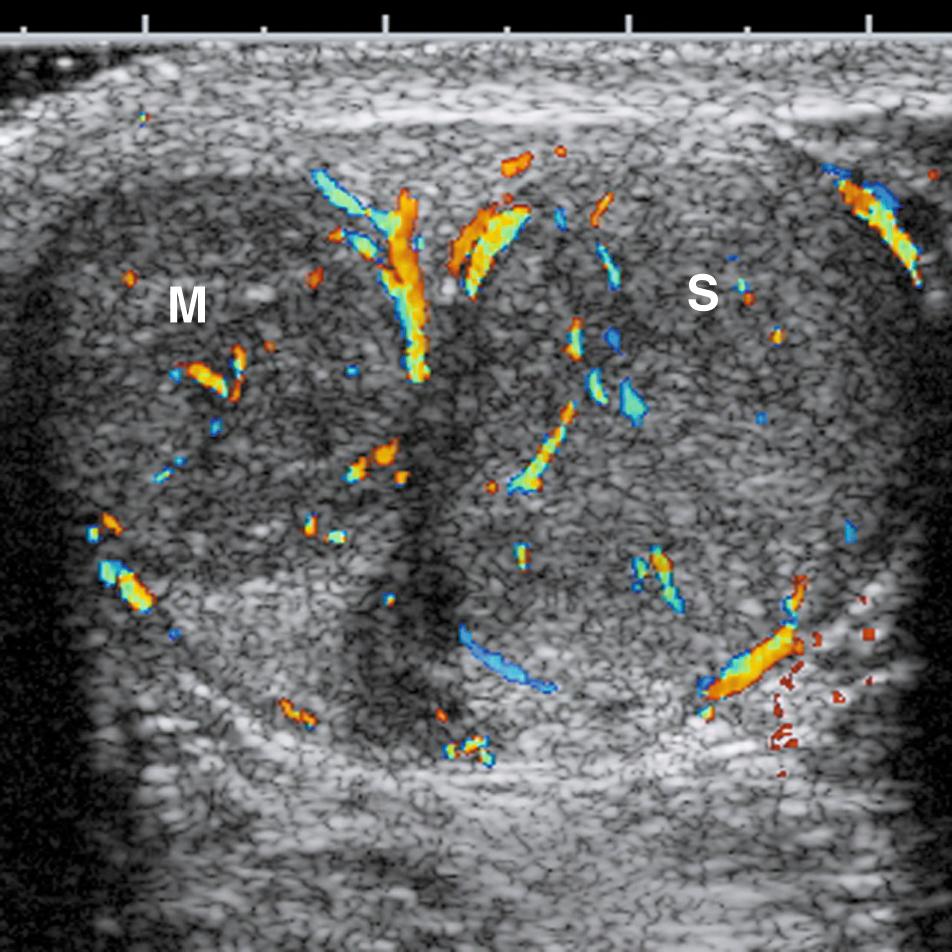
Seminoma is the most common tumor type in cryptorchid testes. Between 8% and 30% of patients with seminoma have a history of undescended testes. The risk of a seminoma developing is substantially increased in an undescended testis, even after orchiopexy. Patients with a normally located but atrophic testis have an increased risk of seminoma (Video 22.1 ). There is also an increased risk of malignancy developing in the contralateral, normally located testis. Therefore sonography is often used to screen for an occult tumor in both testes after orchiopexy.
Seminomas range from a small, well-circumscribed lesion to large masses replacing the testis. Macroscopically, cellular morphology resembles that of primitive germ cells, which are relatively uniform. The sonographic features of pure seminoma parallel this homogeneous macroscopic appearance. Pure seminomas usually have predominantly uniform, low-level echoes without calcification, and they appear hypoechoic compared with normally echogenic testicular parenchyma ( Fig. 22.5 ). Larger tumors may have a more heterogeneous appearance. In rare cases, seminomas become necrotic and appear partly cystic on sonography ( Fig. 22.5I ).
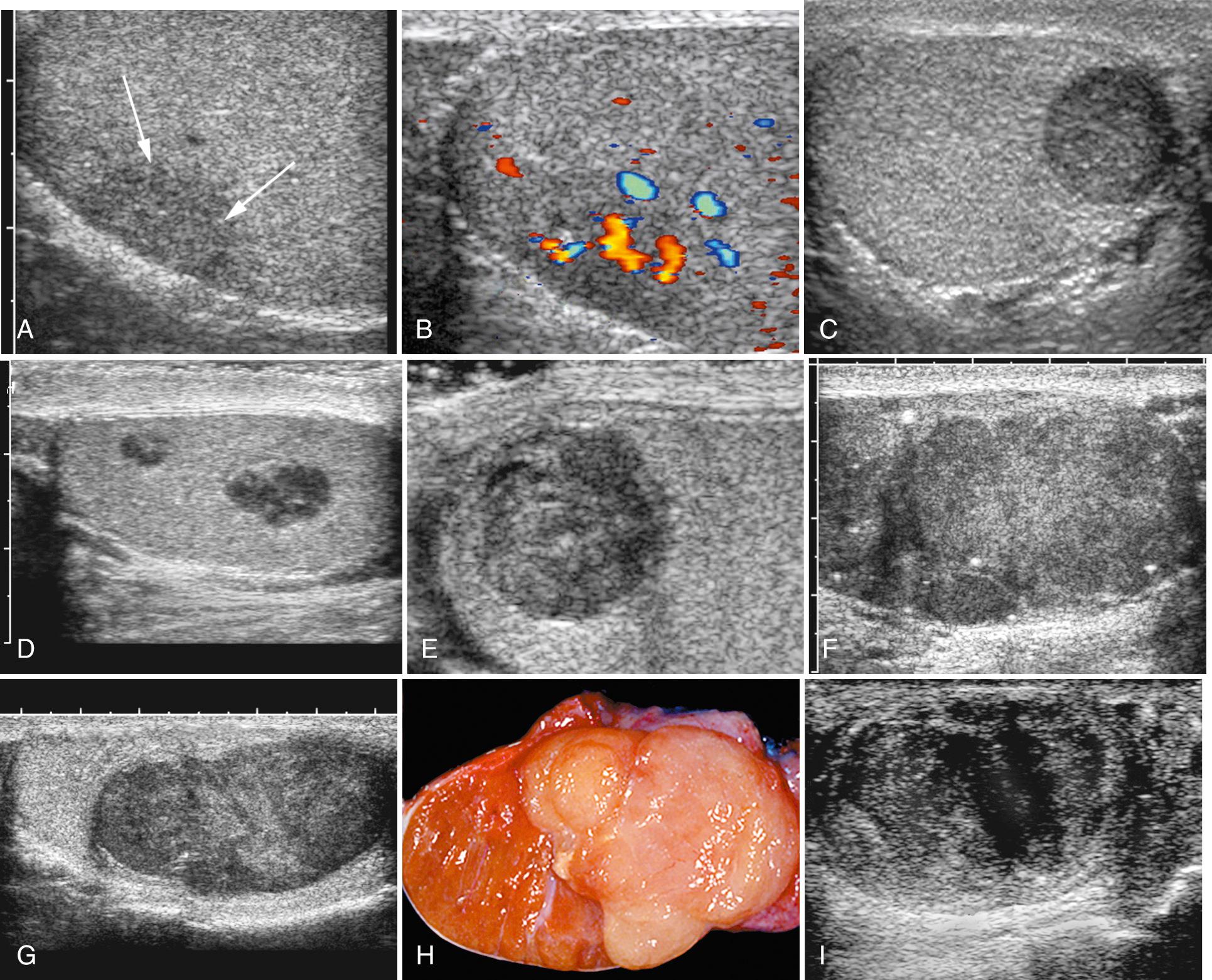
NSGCTs include embryonal carcinomas, teratomas, yolk sac (endodermal sinus) tumors, choriocarcinomas, and mixed germ cell tumors. These tumors occur more often in younger patients than do seminomas, with a peak incidence during the latter part of the second decade and the third decade. They are uncommon before puberty and after age 50. Approximately 70% of NSGCTs produce hormonal markers. Up to 60% of germ cell tumors are mixed germ cell tumors, composed of at least two different cell types. Pure NSGCTs are rare and occur more often in the pediatric population. The sonographic appearance of NSGCTs reflects the histologic features and relative proportions of each component, although as a group these tumors are more heterogeneous than seminoma, demonstrating irregular margins, echogenic foci, and solid and cystic components ( Fig. 22.6 ). These malignancies are more aggressive than seminomas, frequently invading the tunica albuginea and resulting in distortion of the testicular contour (see Fig. 22.6 ). Approximately 60% of NSGCTs have metastatic involvement at presentation.
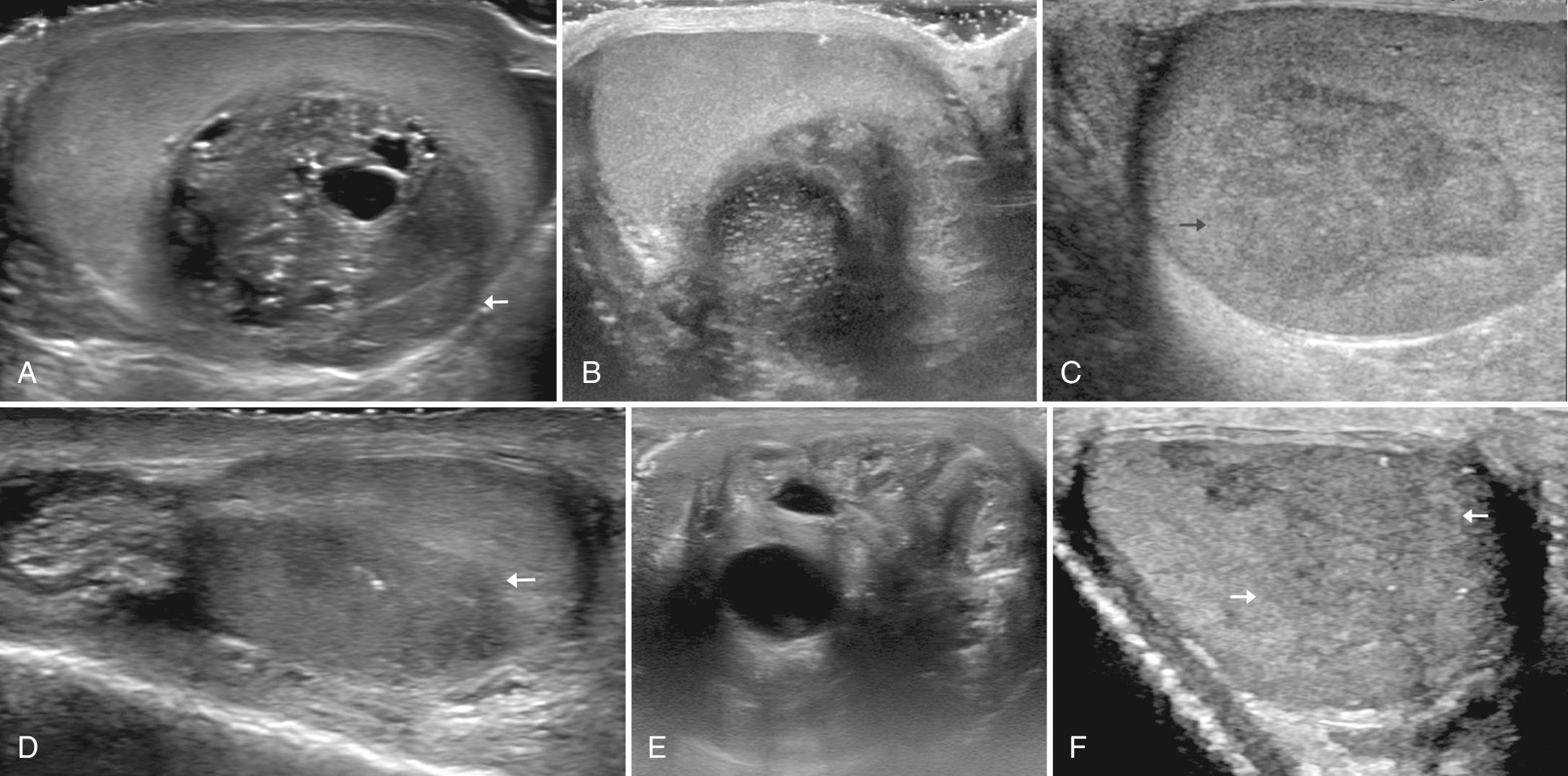
Mixed germ cell tumors are the most common germ cell tumors, constituting up to 60% of all germ cell tumors. They contain nonseminomatous germ cell elements in various combinations. Seminomatous elements may also be present but do not influence prognosis or treatment. Embryonal carcinoma is the most common component, although any combination of cell types may occur. Imaging features are variable, reflecting the diversity of this group of tumors. Nonseminomatous tumors are not as radiosensitive as seminomas. Embryonal carcinoma is composed of primitive anaplastic cells that resemble early embryonic cells. It is present in 87% of mixed germ cell tumors, but in its pure form it is rare, accounting for only 2% to 3% of testicular germ cell neoplasms ( Fig. 22.6C ). As with other NSGCTs, embryonal cell tumors occur in younger patients than seminomas do, with a peak incidence during the latter part of the second and third decades. The sonographic features of pure embryonal cell carcinoma are nonspecific, especially in children, in whom the only finding may be testicular enlargement without a defined mass.
Totipotent germ cells that differentiate toward extraembryonic fetal membranes give rise to yolk sac tumors, or endodermal sinus tumors. Yolk sac tumors are the most common germ cell tumor in infants younger than 2 years, accounting for 80% of childhood testicular neoplasms. Yolk sac tumor is rare in its pure form in adults, although it is present in 44% of adult cases of mixed germ cell tumor ( Fig. 22.6D ). Yolk sac tumor is associated with elevated levels of α-fetoprotein in greater than 90% of infants. Teratomas constitute 5% to 10% of primary testicular neoplasms. They are defined according to the World Health Organization (WHO) classification on the basis of the presence of derivatives of the different germinal layers (endoderm, mesoderm, and ectoderm). Histologically, teratomas can be divided into mature and immature. The peak incidence is in infancy and early childhood, with another peak in the third decade of life. In infants and young children, teratomas are the second most common testicular tumor after yolk sac tumor and are considered benign, even when they are histologically immature. Postpubertal testicular teratomas are malignant and have a higher metastatic rate, approximately 20%, than their ovarian counterpart. Teratomas in their pure form are rare in adults, although teratomatous elements occur in approximately half of all adult cases of mixed germ cell tumor ( Fig. 22.6B ). Both mature and immature teratomas are generally associated with normal tumor markers, although elevated levels of α-fetoprotein or human chorionic gonadotropin may be found. Sonographically, the teratoma is usually a well-defined, markedly heterogeneous mass containing cystic and solid areas of various sizes and appears similar to other NSGCTs. Dense echogenic foci causing acoustic shadowing are common, resulting from focal calcification, cartilage, immature bone, fibrosis, and noncalcific scarring ( Fig. 22.6E ).
Choriocarcinoma accounts for less than 1% of malignant primary testicular tumors in its pure form but occurs in 8% of mixed germ cell tumors. The peak incidence is in the second and third decades. These tumors are highly malignant and metastasize early by hematogenous and lymphatic routes. The primary tumor and metastases are often hemorrhagic, and patients may have symptoms resulting from hemorrhagic metastases, including hemoptysis, hematemesis, and central nervous system–related symptoms. Focal necrosis of the primary tumor secondary to hemorrhage is an almost invariable feature, and calcification may be present, giving a sonographic appearance similar to the other NSGCTs ( Fig. 22.6F ). The levels of human chorionic gonadotropin are elevated and cause gynecomastia in 10% of cases. Choriocarcinoma has the worst prognosis of any of the germ cell tumors.
Sonography is an important diagnostic tool for patients who present with widespread metastatic testicular carcinoma ( Fig. 22.7 ) even though the primary tumor has involuted ( Fig. 22.8 ); ultrasound is an important component in the search for a primary testicular neoplasm. Mediastinal and central nervous system extragonadal tumors can often present as primary lesions, although retroperitoneal germ cell tumors are more likely to have a testicular origin. The primary testicular tumor may regress, despite widespread advancing metastatic disease, resulting in an echogenic fibrous and possibly calcific scar. Regression may be caused by the high metabolic rate of the tumor and vascular compromise from the tumor outgrowing its blood supply. Tumors are typically clinically occult with the affected testis normal or small on palpation. Histologic analysis may reveal no residual tumor, although intratubular malignant germ cells may be present. These lesions, also known as “Azzopardi tumors,” have a variable sonographic appearance; they can be hypoechoic or hyperechoic or seen as focal calcifications. Although sonographic appearance is not specific for a “burned-out” or regressed tumor, findings are suggestive in the context of histologically proven testicular metastases.
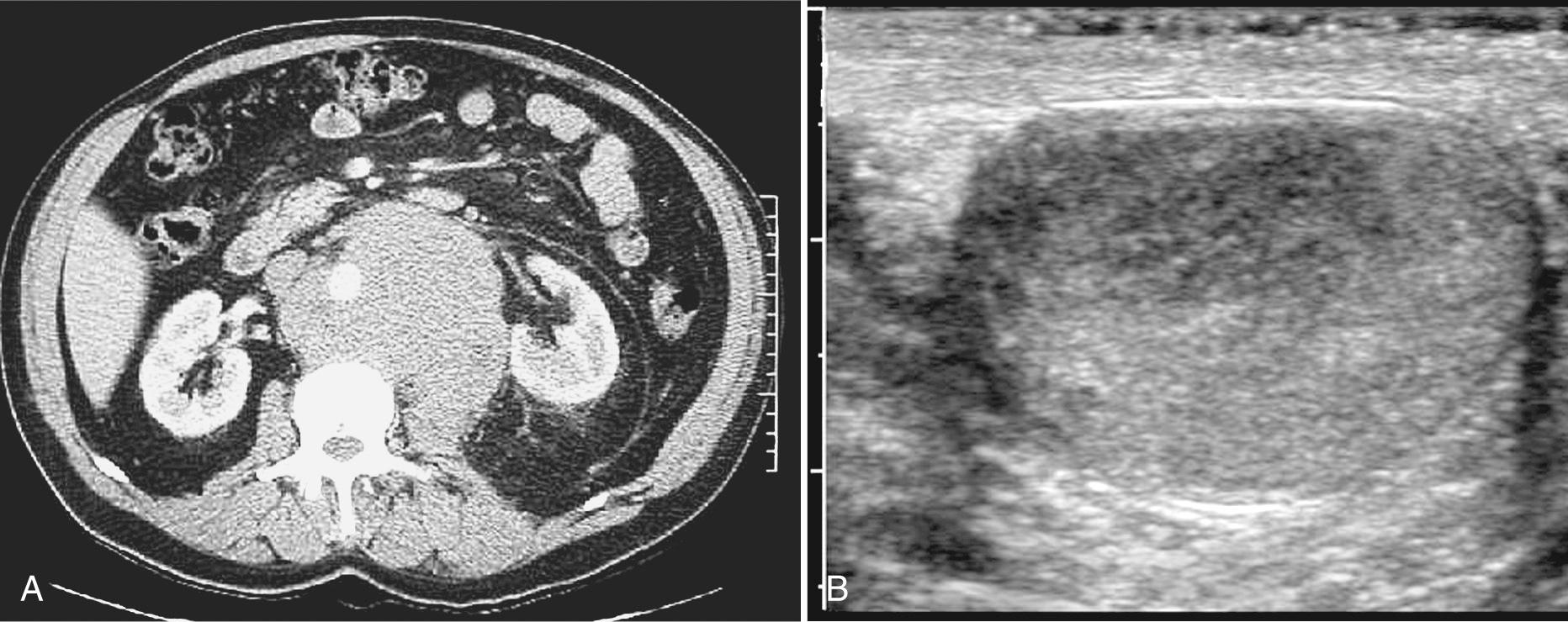

Sex cord–stromal tumors account for 3% to 6% of all testicular neoplasms. The prevalence is greater in the pediatric population where non–germ cell tumors account for 10% to 30% of all testicular neoplasms. The term sex cord–stromal tumor refers to a neoplasm containing Leydig, Sertoli, thecal, granulosa, or lutein cells and fibroblasts in various degrees of differentiation. These tumors may contain single or multiple cell types because of the totipotentiality of the gonadal stroma.
The most common type of sex cord–stromal tumor is a Leydig cell tumor, accounting for 1% to 3% of all testicular neoplasms; these can occur in any age group, although predominantly in patients aged 20 to 50 years. Patients most often present with painless testicular enlargement or a palpable mass. Approximately 30% of patients present with an endocrinopathy secondary to secretions of androgens or estrogens by the tumor, which may manifest as precocious virilization, impotence, or loss of libido. The tumor is bilateral in 3% of cases. From 10% to 15% of the tumors are malignant, having invaded the tunica at diagnosis. These gonadal tumors are usually small, solid, homogeneous hypoechoic masses on sonography and may show mainly peripheral flow on color Doppler imaging ( Fig. 22.9A and B ). Foci of hemorrhage and necrosis are present in 25% of tumors, and thus cystic spaces due to hemorrhage and/or necrosis are occasionally seen in larger lesions.
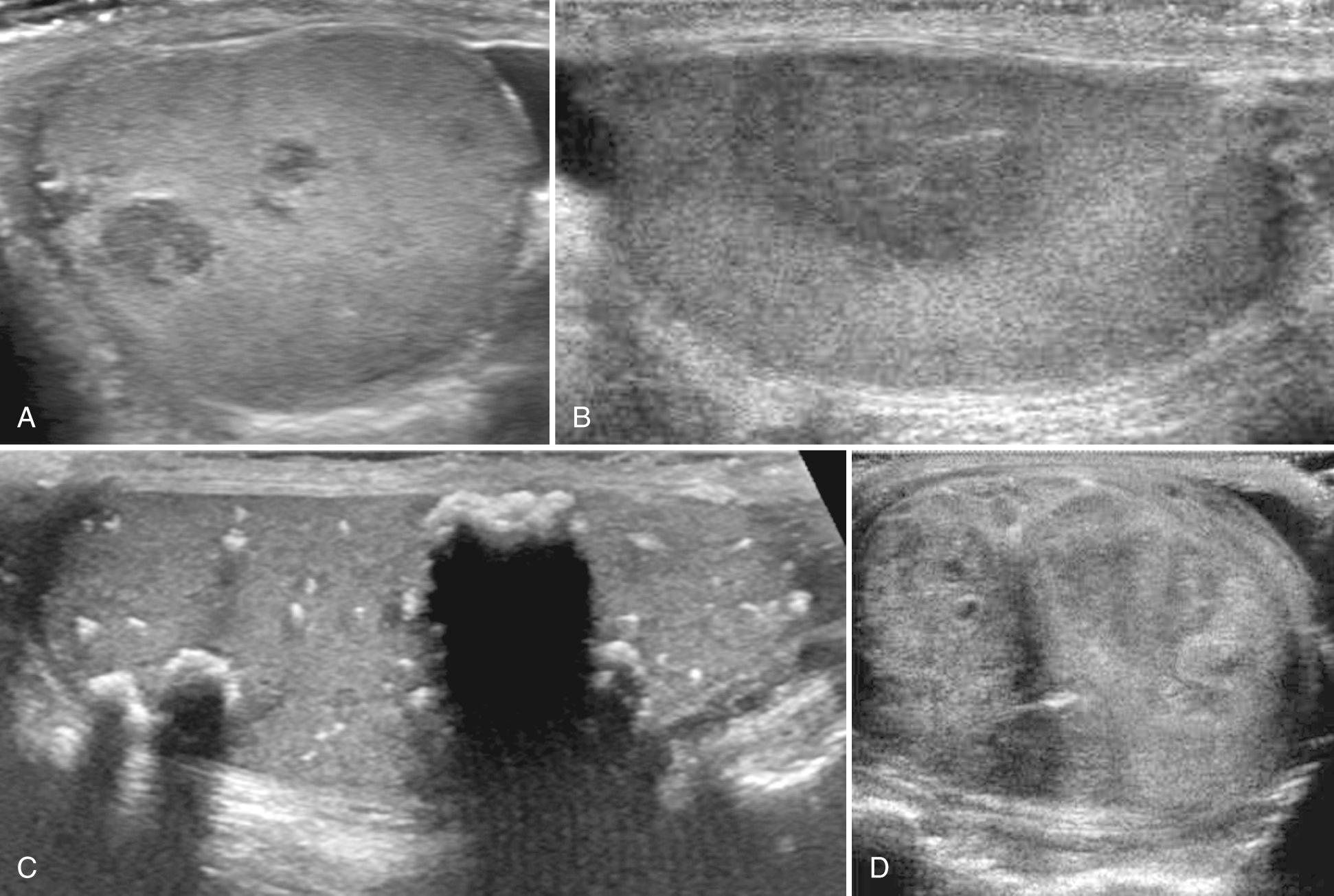
Sertoli cell tumors are rare and account for less than 1% of all testicular tumors; they occur with equal frequency in all age groups. They can be of one of three histologic types: Sertoli cell tumor not otherwise specified, sclerosing Sertoli cell tumor, or large cell calcifying Sertoli cell tumor. The most common presentation is with a painless intratesticular mass. These tumors are less likely than Leydig cell tumors to be hormonally active, although gynecomastia may occur. Sertoli cell tumors may occur in undescended testes, in patients with testicular feminization, Klinefelter syndrome, and Peutz-Jeghers syndrome. Sertoli cell tumors are typically well-circumscribed, unilateral, rounded to lobulated masses. Occasionally, hemorrhage or necrosis may occur, giving a more heterogeneous appearance on sonography. The large-cell calcifying Sertoli cell tumor is a subtype with distinctive clinical, histologic, and sonographic features. These tumors are often bilateral and multifocal and may be almost completely calcified. Carney complex, a very rare autosomal dominant multiple endocrine neoplasia syndrome, is often associated with Sertoli cell tumors ( Fig. 22.9C ).
Additional, less common tumors in this category include granulosa cell tumors, fibroma-thecomas, and mixed sex cord–stromal tumors ( Fig. 22.9D ). Gonadal stromal tumors in conjunction with germ cell tumors are called gonadoblastomas. The majority of gonadoblastomas occur in the setting of gonadal dysgenesis and intersex syndromes.
Lymphoma accounts for 5% of all testicular tumors and is the most common testicular tumor in men older than 60 years, where it can account for up to 50% of intratesticular masses. However, testicular involvement occurs in only 1% to 3% of patients with lymphoma. The peak age at diagnosis of lymphoma is 60 to 70 years; 80% of the patients are older than 50 years at diagnosis. Malignant lymphoma is the most common bilateral testicular tumor, occurring bilaterally either in a synchronous or, more often, in a metachronous manner in up to 38% of cases. One-half of bilateral testicular neoplasms are lymphoma. Most lymphomas of the testis are B-cell lymphomas, with diffuse large cell lymphoma being the most common. Hodgkin lymphoma of the testis is extremely rare.
Mostly non-Hodgkin lymphoma
Second most common
Acute leukemia: 40%-65%
“Sanctuary” site
Become a Clinical Tree membership for Full access and enjoy Unlimited articles
If you are a member. Log in here